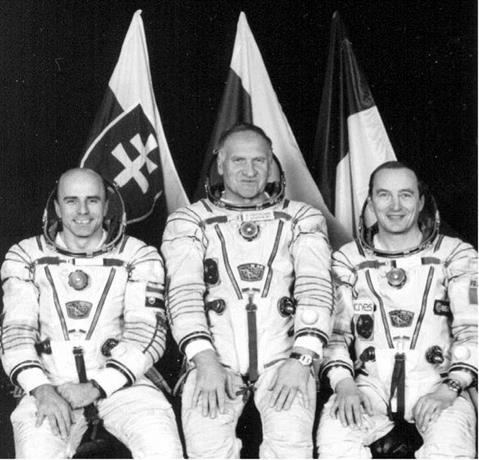. SOYUZ TM29
Flight Crew
AFANASYEV, Viktor Mikhailovich, 50, Russian Air Force, 3rd mission Previous missions: Soyuz TM11 (1990); Soyuz TM18 (1994)
HAIGNERE, Jean-Pierre, 50, French Air Force, flight engineer, 2nd mission Previous mission: Soyuz TM17
BELLA, Ivan, 34, Slovak Armed (Air) Forces, cosmonaut researcher
Flight Log
This was to prove the final in-orbit hand-over of a Mir crew on a station that had been continually manned since September 1989. The short Slovak Stefanik scientific mission was reportedly paid for by the Russians writing off a Soviet era debt to Slovakia of US$20 million. France reportedly paid US$20.6 million for the Perseus programme, which should have been completed in June but was extended at no extra cost until August.
The Slovak programme encompassed medical experiments, measurements of radiation and observations of the development of quail eggs. Haignere’s Perseus programme included the use of equipment brought up in previous French missions as well as four new experiments. The programme focused on life sciences, physics and space technology. Two other experiments were provided by ESA and there were several experiments provided by French high schools working in cooperation with CNES. On 16 April, Haignere and Afanasyev competed a 6 hour 19 minute EVA in which they were to test a new sealant tool for repairing small holes in the hull. A simulated hole in Kvant was to be used in the test, and the sealant was also to have been used for Spektr, but the hole in the module was never pinpointed. In the test, the valve failed to open and the simulation at Kvant had to be cancelled. The EVA crew did retrieve experiment samples from the exterior of the station, but the deployment of new detectors had to be abandoned as they fell behind schedule.
|
Slovakia’s first cosmonaut Bella (left) was launched aboard Soyuz TM29 with Russian Afanasyev (centre) and Frenchman Haignere |
The three men continued their programmes of biomedical studies, astrophysical and technical experiments and Earth photography, as well as astronomical and solar observations, filling the weeks as they orbited in Mir. In June, Avdeyev surpassed the career record of 681 days accumulated time in space (previously held by Dr. Valery Polyakov). According to some reports, not all the time spent on Mir was harmonious, with Afanasyev not enjoying his third mission to Mir and at times being at odds with Haignere. Two EVAs by Afanasyev and Avdeyev were completed in July (23 Jul for 6 hours 7 minutes and 27 Jul for 5 hours 22 minutes) to deploy an elliptical 6.4 x 5.2m reflector antenna that was 1.1m high. This was a test of a new prototype design for a telecommunications antenna planned for future generations of satellites. It initially refused to deploy and remained furled despite the crew kicking it. During the second EVA, they were able to complete the deployment operation. Over the course of the two EVAs, they also deployed and returned experiments and sample cassettes on the exterior of the station, and during the second EVA they detached the antenna from the Sofora girder, manually pushing it away from the station.
On 25 July, Haignere spoke over the radio to fellow French astronaut Michel Tognini, who was on Columbia during the STS-93 mission. Towards the end of July and in Early August, the crew’s scientific work began to come to an end and for several days the three cosmonauts began winding up their experiments and mothballing the station. Later, they witnessed the effects of the 11 August 1999 total solar eclipse as the shadow passed over southern England, and over the Indian sub-continent one orbit later.
On 27 August, the crew undocked from Mir to complete a landing a few hours later. Afanasyev said that his crew were “abandoning a piece of Russia [with] grief in our souls.’’ According to Russian press releases, there had been over 22,000 scientific experiments in 20 research programmes, utilising over 240 pieces of scientific equipment. A total of 14 tons of scientific hardware had been used on Mir by the 27 main crews and numerous visiting crew members. For now, there did not seem to be any further missions on the horizon, although Mir was kept in autonomous flight while all options were examined. The Russians seemed to have committed themselves to ISS and the end of Mir was approaching.
Milestones
211th manned space flight 88th Russian manned space flight 81st manned Soyuz mission 28th manned Soyuz TM mission 29th Mir resident crew
34th Russian and 73rd flight with EVA operations 6th French long-duration mission (189 days)
Haignere celebrates his 51st birthday on Mir (19 May)
New duration record of 748 days in space set by Avdeyev over three missions New duration record of 209 days in space for a non-Russian (Haignere)











